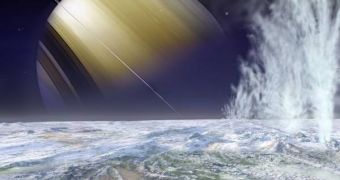According to recent reports, it may be that the thing keeping the liquid water and vapors on the icy Saturn moon Enceladus from freezing is nothing else than a natural form of antifreeze. The most important chemical in such a cocktail is ammonia, which has the ability to significantly alter the temperature points at which substances move from one of their states (solid, liquid, gaseous, etc.) to another. The find has been made using the Cassini space probe, which identified traces of the chemical compound last October, while analyzing emission plumes coming from the moon's surface.
Since then, studies have revealed that these plumes are largely made up of water vapors and carbon dioxide, but a special instrument on Cassini that was used for the analysis revealed also traces of ammonia, which is known on our planet as a potent antifreeze.
“This is the first time Cassini has actually been able to ’smell’ ammonia. And because ammonia is an antifreeze, it probably ensures that there is liquid water in the interior of Enceladus,” University of Arizona Planetary Scientist Jonathan Lunine says. He is the co-author of a new study detailing the theory, published in the Wednesday issue of the prestigious scientific journal Nature.
In a June issue of Nature, another study identified the fact that the E Ring of Saturn, the area in which Enceladus orbits its parent planet, also comprised sodium salts. “I’m pretty convinced. By itself, the findings we have are strong. But they’re made even stronger by the article in Nature last month that found, using a different instrument on Cassini, that there are sodium and ice particles on the E-ring,” the expert says. Together, the two papers make an excellent argument that an ocean of liquid water, and maybe even life, may exist just below the surface of the moon.
“I’d love to have a situation where we actually dipped our toes into the water, although I’m not sure I’d want to do it barefoot. But we’re not going to be able to do that. Just the fact that we can sample the water – smell it if you will – by studying the gas in the plumes, is pretty great,” Lunine adds. Conversely, there are also critics to the paper, which believe that the plumes may be explained without introducing liquid water in the equation, Wired informs.
“The argument in this paper hinges on an early announcement by NASA that temperatures in excess of 180 Kelvin have been reported. It sounds like a small difference, but it’s huge in terms of the ammonia-water system,” University of Illinois Space Scientist Susan Kieffer, whose skepticism of water on Enceladus was not hindered by the new paper, points out.

 14 DAY TRIAL //
14 DAY TRIAL //